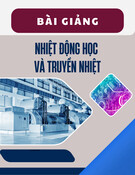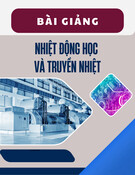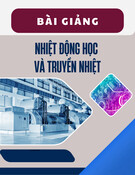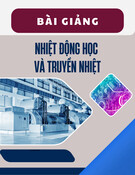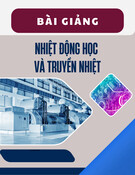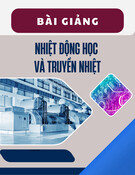
REGULAR ARTICLE
Effect of heat transfer correlations on the fuel temperature
prediction of SCWRs
Erick-Gilberto Espinosa-Martínez
1,*
, Cecilia Martin-del-Campo
1
, Juan-Luis François
1
and Gilberto Espinosa-Paredes
2,3
1
Departamento de Sistemas Energéticos, Facultad de Ingeniería, Universidad Nacional Autónoma de México, C.P. 62550
Jiutepec, Mor., Mexico
2
Área de Ingeniería en Recursos Energéticos, Universidad Autónoma Metropolitana-Iztapalapa, C.P. 09340 México, D.F.,
Mexico
3
Sabbatical leave at the Facultad de Ingeniería of the Universidad Nacional Autónoma de México through the Programa de
Estancias Sabáticas del CONACyT, México, D.F., Mexico
Received: 9 June 2015 / Received in final form: 17 May 2016 / Accepted: 20 July 2016
Abstract. In this paper, we present a numerical analysis of the effect of different heat transfer correlations on
the prediction of the cladding wall temperature in a supercritical water reactor at nominal operating conditions.
The neutronics process with temperature feedback effects, the heat transfer in the fuel rod, and the thermal-
hydraulics in the core were simulated with a three-pass core design.
1 Introduction
The super critical water reactor (SCWR) is one of the most
promising and innovative designs selected by the Genera-
tion IV International Forum. This is a very high-pressure
water-cooled reactor which will operate at conditions
above the thermodynamic critical point. Water enters the
reactor core and then exits without change of phase, i.e., no
water/steam separation is necessary. There is an increase
of thermal efficiency of current nuclear power plants from
30–35% to approximately 45–50%.
Figure 1 shows the difference in the operating
conditions of current generation reactor systems in
comparison to SCWRs. Compared to existing pressurized
water reactors (PWRs), in SCWRs the target is to increase
the coolant pressure from 10–16 MPa to about 25 MPa; the
inlet temperature to about 350 °C, and the outlet
temperature to about 625 °C[
1].
In this paper, we presented a numerical analysis of the
effect of different heat transfer correlations on the
prediction of fuel and wall cladding temperatures in a
supercritical water reactor. The neutronics process with
temperature feedback effects, the heat transfer in the fuel
rod and the thermal-hydraulics in the core were simulated.
Special attention was given to the thermal-hydraulics,
which uses a three-pass core design with multiple heat-up
steps, where each step was simulated using an average
channel. The first pass called “evaporator”is located in the
center of the core. In this region, the moderator water flows
downward in gaps between assembly boxes and inside the
moderator tubes. The moderator water, heated-up through
its path downward to the lower plenum, is mixed with the
coolant coming from the downcomer reaching an inlet
temperature of around 583 K. The evaporator heats the
coolant up to 663 K, flowing upward and around the fuel
rods, resulting in an outlet temperature 5 K higher than the
pseudo-critical temperature of 557.7 K at a pressure of
25 MPa. The second pass, called “superheater”, with
downward flow, heats the coolant up to 706 K. After a
second mixing in an outer mixing plenum below the core,
the coolant will finally be heated up to 803 K with an
upward flow in a second superheater (the third pass)
located at the core periphery. A transient one-dimensional
radial conduction model was applied in the fuel rod for each
cell in the axial coordinate. Energy balances for the coolant
have been implemented using a steady state and a one-
dimensional model for the axial coordinate. Fuel lattice
neutronics calculations were performed with the HELIOS-
2 code and the reactivity coefficients were used to evaluate
the reactivity effects due to changes in the fuel temperature
and in the supercritical water density for 177 energy
groups. Due to the strong variation of coolant density
through the core, five densities were considered. This safety
parameter is calculated in order to evaluate the variation of
the reactivity due to the Doppler effect, as a function of
the fuel temperature, which is related to the resonances
broadening when the fuel temperature increases.
* e-mail: yurihillel@gmail.com
EPJ Nuclear Sci. Technol. 2, 35 (2016)
©E.-G. Espinosa-Martínez et al., published by EDP Sciences, 2016
DOI: 10.1051/epjn/2016030
Nuclear
Sciences
& Technologies
Available online at:
http://www.epj-n.org
This is an Open Access article distributed under the terms of the Creative Commons Attribution License (http://creativecommons.org/licenses/by/4.0),
which permits unrestricted use, distribution, and reproduction in any medium, provided the original work is properly cited.

The coupling of neutronics with the heat transfer in the fuel
rod, and the thermal-hydraulics is presented, and numeri-
cal experiments due to changes in the mass flow rate were
accomplished in this study. Effects on fuel temperature
predictions with improved heat transfer correlations and
classical heat transfer correlations were also compared.
2 Supercritical fluids
The behavior of liquid and gas density with pressure and
temperature is illustrated in Figure 2. When the pressure
and temperatures are low, there is a significant density
difference between the liquid and the gas states. Near the
critical point, the density difference between the liquid and
gas is small, and above the critical point, the densities of the
liquid and the gas have become equal.
The heat transfer process, at critical and supercritical
pressures, is influenced by the significant changes in
thermophysical properties, as is observed in Figure 3 for
specific heat, thermal conductivity, and density obtained
from thermal properties taken from [3]. The most signifi-
cant thermophysical property variations occur near the
critical and pseudocritical points. For example, the specific
heat of water has a maximum value at the critical point.
The exact temperature that corresponds to the specific
heat peak at pressures above the critical pressure is known
as the pseudocritical temperature [4].
3 Supercritical water heat-transfer
correlation
The practical prediction methods for heat transfer at
supercritical pressures are presented in [1,4]. The super-
critical water heat transfer correlations applied in this work
are shown in Table 1. Dimensionless numbers used in
Table 1 are given by:
Nub¼H∞
kbDH
;ð1Þ
which is the Nussel number. Here H
∞
is the heat transfer
coefficient, kis the thermal conductivity and D
H
is the
hydraulic characteristic length. The subscript bmeans that
bulk-fluid temperature is used to calculate the thermo-
physical properties. These properties can also be calculated
with the wall temperature, which will be specified with a
subscript w. The Reynolds number is defined by:
Reb¼GDH
mb
;ð2Þ
where Gis the mass flux and mis the viscosity. The Prandtl
number is defined as:
Prb¼Cpbmb
kb
;ð3Þ
where Cp is the specific heat. The heat transfer coefficient is
used in the boundary condition given below in equation (6),
and H
∞
represents the heat transfer from the wall to the
coolant. McAdams [6] proposed the use of the Dittus-
Boelter correlation for forced-convective heat transfer in
turbulent flows at subcritical pressures. The only difference
between the Dittus-Boelter and McAdams correlations is
that the latter has a larger coefficient. According to
Schnurr et al. [10], it agrees with experimental data.
However, it was noted that the correlation might produce
unrealistic temperature results near the critical and
pseudocritical points, due to it being very sensitive to
variations in the thermophysical properties.
Fig. 3. Behavior of the specific heat (C
p
), thermal conductivity (k) and density (r), as a function of the temperature at 25 MPa.
E-G Espinosa-Martínez et al.: EPJ Nuclear Sci. Technol. 2, 35 (2016) 3

Bishop et al. [7] conducted experiments in supercriti-
cal water flowing upward inside bare tubes and
annuli, within the following range of operating param-
eters: P= 22.8–27.6 MPa, T
b
=282–527 °C, m=651-
–3662 kg/m
2
sandq=0.31–3.46 MW/m
2
.Theirdata
for heat transfer in tubes were generalized with a fitof
±15%. This correlation uses a cross-sectional averaged
Prandtl number and the final term in the correlation
(1 + 2.4 D/x) accounts for the entrance-region effect.
Bishop et al.'s correlation was modifiedandusedwithout
the entrance-region term, because this term depends
significantly on the particular design of the inlet of the
bare test section.
Swenson et al. [8] have suggested a correlation in which
thermophysical properties are mainly based on a wall
temperature, as they found that conventional correlations,
which use a bulk-fluid temperature as a basis for
calculating the majority of thermophysical properties,
did not work as well.
A dimensional analysis was performed by Mokry
et al. [9] in order to obtain a general empirical form of
correlation for the heat transfer calculations, and as a result
of the experimental data analysis, two correlations for the
heat transfer coefficient at supercritical water conditions
were obtained.
In the core layout of the SCWR under study, water, as
the working fluid, is guided three times through the core
(twice up and once down). This design is called the three-
pass core concept. The first pass, called the evaporator, is
situated in the center of the core. In this region, the
moderator water flows downward in gaps between
assembly boxes and inside the moderator tubes. The
moderator water, in its downward path to the lower
plenum is heated up, and is mixed with the coolant
(1200kg/sasinletmassflow) which comes from the
downcomer, thereby reaching an inlet temperature of
around 583 K. The evaporator heats the coolant up to
663 K, flowing upward around the fuel rods, resulting in
an outlet temperature 5 K higher than the pseudo-critical
temperature of 557.7 K at a pressure of 25 MPa. An inner
steam plenum above the core eliminates hot streaks.
The second pass, called superheater, with a downward
flow, heats the coolant up to 706 K. After a second mixing
in an outer mixing plenum below the core, the coolant is
finallyheatedupto803Kwithanupwardflow in a second
superheater located at the core periphery, known as the
third pass. Each pass, the evaporator and both super-
heaters, is built of 52 fuel assembly clusters as shown in
Figure 4 [11]. Therefore the complete reactor core is
composed of 156 assembly clusters.
The fuel assembly design is taken from the European
high performance light water reactor (HPLWR) concept.
The 7 7 square arrangement design, with 40 fuel rods
distributed in dual rows, and a single water tube replacing
9 fuel rods was used [12]. The fuel rods and the water tube
are housed within the assembly box and grouped in a
cluster of 9 assemblies, in a 3 3 arrangement with similar
dimensions to a PWR assembly. As found in the PWR,
control rods are inserted from the core top into 5 of the 9
water tubes of a cluster (Fig. 4b). The structural material
for cladding, assembly boxes and water tubes is stainless
steel. The main reactor parameters are presented in
Table 2.
4 Implementation of the heat transfer
correlations
In order to analyze the effect of different heat transfer
correlations on the prediction of the wall temperature of
the fuel rods, the SCWR numerical code developed by
Barragán-Martínez [15] was applied using the HTCs shown
in Table 1. The numerical model of the heat transfer
processes in the fuel element of the HPLWR was obtained
using the numerical model of typical reactors [16]. The
supercritical water reactor is integrated of cylindrical fuel
elements which contain ceramic pellets inside the cladding.
Then, the effect of heat transfer correlations on the
fuel temperature prediction of SCWRs was conducted with
numerical experiments.
Table 1. Supercritical water heat-transfer correlations (HTCs).
Correlation Reference
Nub¼0:023Reb
0:8Prb
0:4Dittus and Boelter [5]
Nub¼0:0243Reb
0:8Prb
0:4McAdams [6]
Nub¼0:0069Reb
0:9〈Prb〉0:66 rw
rb
0:43
1þ2:4D
x
Bishop et al. with ERE
a
[7]
Nub¼0:0069Reb
0:9〈Prb〉0:66 rw
rb
0:43 Bishop et al. without ERE [7]
Nuw¼0:00459Rew
0:923 〈Prw〉0:613 rw
rb
0:231 Swenson et al. [8]
Nub¼0:0053Reb
0:914 〈Prb〉0:654 rw
rb
0:518 Mokry et al. preliminary [9]
Nub¼0:0061Reb
0:904 〈Prb〉0:684 rw
rb
0:564 Mokry et al. final [9]
a
With entrance-region effect (ERE) and a fitof±15%; 〈Pr 〉is the average; band wmeans bulk-fluid and wall temperature,
respectively.
4 E-G Espinosa-Martínez et al.: EPJ Nuclear Sci. Technol. 2, 35 (2016)

4.1 Fuel heat transfer model
A detailed multi-node fuel pin model was developed for this
study. The fuel heat transfer formulation is based on the
following fundamental assumptions:
–axis-symmetric radial heat transfer,
–the heat conduction in the axial direction is negligible,
–the volumetric heat rate generation in the fuel is uniform
in each radial node, and
–storage of heat in the fuel cladding and gap is negligible.
Under these assumptions, the transient temperature
distribution in the fuel pin, and the initial and boundary
conditions are given in the following conditions:
rCp ∂T
∂t¼k
r
∂
∂rr∂T
∂r
þq000 ðtÞ;at rrrf;ð4Þ
I:C:Tðr;0Þ¼TðrÞ;at t¼0;ð5Þ
B:C:1k∂T
∂r¼H∞ðTwTmÞ;at r¼rcl;ð6Þ
B:C:2∂T
∂r¼0;at r¼r0:ð7Þ
In equation (4) q000 (t) = 0, for r
f
r
cl
. In these equations,
ris the cylindrical radial coordinate, r
0
,r
f
and r
cl
are the
centroid, fuel and clad radius, respectively, q000 (t)=P(t)/V
f
at each axial node, where Pis the neutronics power, T
m
is
the moderator temperature, and H
∞
is the convective heat
transfer coefficient.
The differential equations described previously are
transformed into discrete equations using the control
volume formulation technique in an implicit form [17]. The
control volume formulation enables the equations for fuel,
gap, and cladding to be written as a single set of algebraic
equations for the sweep in the radial direction:
ajTtþDt
j¼bjTtþDt
jþ1þcjTtþDt
j1þdj;ð8Þ
Fig. 4. (a) Arrangement of evaporator, superheater 1, superheater 2, and assembly clusters in the core, (b) assembly cluster with
water tubes and control rods.
Table 2. Main reactor parameters [12–14].
Reactor parameter Reference value
Thermal power 2300 MWt
Efficiency 43.5%
Pressure 25 MPa
Inlet core temperature 553 K
Outlet core temperature 773 K
Inlet mass flow 1179 kg/s
Fuel
a
UO
2
Cladding Stainless steal
Total number of fuel rods in the core 56,160
a
UO
2
with U enriched to 5% U-235 for all the fuel rods in the
bundle except the corner rod which is enriched to 4%
E-G Espinosa-Martínez et al.: EPJ Nuclear Sci. Technol. 2, 35 (2016) 5





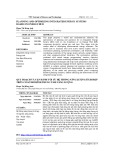
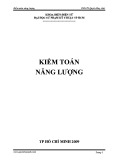
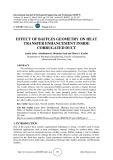
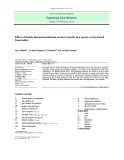
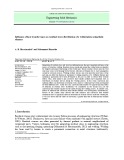








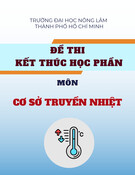

![Ngân hàng trắc nghiệm Kỹ thuật lạnh ứng dụng: Đề cương [chuẩn nhất]](https://cdn.tailieu.vn/images/document/thumbnail/2025/20251007/kimphuong1001/135x160/25391759827353.jpg)
